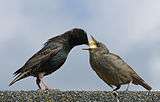Mesocarnivore

A mesocarnivore is an animal whose diet consists of 50–70% meat with the balance consisting of non-vertebrate foods which may include fungi, fruits, and other plant material.[1] Mesocarnivores are seen today among the Canidae (coyotes, many foxes), Viverridae (civets), Mustelidae (martens, tayra), Procyonidae (ring-tailed cat), Mephitidae (skunks), and Herpestidae (some mongooses).
Dentition
Mesocarnivore cheek teeth are heterodont and their different shapes reflect distinct functions. Incisors and canines are used to apprehend food and kill prey, pointed premolars pierce and hold prey, and molars are involved in both slicing and crushing functions. The slicing function of the molars is produced by occlusion between the carnassials, the lower first molar, and the upper fourth premolar.
Mesocarnivores represent the earliest Miacoidea family of Miacidae. They are best represented by Prohesperocyon, species P. wilsoni, with 3 incisors, 1 canine tooth, 4 premolars above. The jaw has 3 molars below, and 2 molars above on each side.[2]
See also
Sources
- ↑ Van Valkenburgh, B. "Déjà vu: The evolution of feeding morphologies in the Carnivora". Oxford Journals. Retrieved January 26, 2014.
- ↑ Radinsky, L.B. (1982). "Evolution of skull shape in carnivores. 3. The origin and early radiation of the modern carnivore families". Paleobiology. 8: 177–95.
